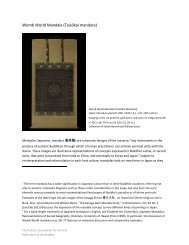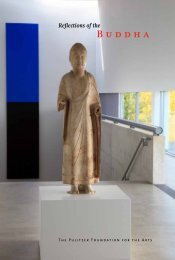Four-circle Hevajra Mandala - Reflections of the Buddha
Four-circle Hevajra Mandala - Reflections of the Buddha
Four-circle Hevajra Mandala - Reflections of the Buddha
You also want an ePaper? Increase the reach of your titles
YUMPU automatically turns print PDFs into web optimized ePapers that Google loves.
<strong>Four</strong>-<strong>circle</strong> <strong>Hevajra</strong> <strong>Mandala</strong> 6<br />
The composition <strong>of</strong> this thangka is bounded at top and bottom by a register <strong>of</strong> figures depicted in<br />
arcaded niches. Such a compositional device seems to be unique to, and ubiquitous in, Sakya-school<br />
painting from <strong>the</strong> fourteenth through seventeenth centuries. 18 Stylistically similar arches—composed <strong>of</strong><br />
<strong>the</strong> same gilt, vase-like columns, supported by lotus pedestals and supporting semicircular arches,<br />
among which are depicted gilt lozenges surrounded by red and green leaves—may be found in a<br />
fifteenth-century Bhūtadāmara <strong>Mandala</strong> from a central Tibetan Sakyapa 19 monastery, now held in a<br />
private collection. 20 The thangka from <strong>the</strong> private collection, however, appears to have been painted<br />
with even greater care than <strong>the</strong> Harvard thangka: <strong>the</strong> lines are stronger and more even, <strong>the</strong> colors have<br />
been applied more smoothly, and <strong>the</strong> forks <strong>of</strong> <strong>the</strong> foliated flames are finer. Despite <strong>the</strong> differences in<br />
<strong>the</strong> fineness <strong>of</strong> <strong>the</strong> execution <strong>of</strong> <strong>the</strong> two thangkas, <strong>the</strong>y share many stylistic similarities, perhaps giving<br />
fur<strong>the</strong>r support to <strong>the</strong> recent re-attribution <strong>of</strong> <strong>the</strong> Harvard mandala from <strong>the</strong> seventeenth or eighteenth<br />
century to <strong>the</strong> fifteenth or sixteenth century. 21 The lack <strong>of</strong> any cloudforms or landscape elements in <strong>the</strong><br />
Harvard mandala—motifs that appear rarely, if ever, in mandalic thangkas prior to <strong>the</strong> seventeenth<br />
century—seems to preclude <strong>the</strong> possibility that this work dates from a later period. 22 Indeed, <strong>the</strong> work<br />
possesses all <strong>of</strong> <strong>the</strong> elements that Pratapaditya Pal enumerates as hallmarks <strong>of</strong> <strong>the</strong> Sakya painting style<br />
from <strong>the</strong> fourteenth through seventeenth centuries—namely, “(i) <strong>the</strong> ubiquitous use <strong>of</strong> red…; (ii) strictly<br />
linear definition <strong>of</strong> form; (iii) employment <strong>of</strong> elaborate shrines with ornate columns from which spring<br />
foliate arches … carrying mythical creatures such as makara, garuda, [and] nāga …; (iv) registers <strong>of</strong><br />
figures both at <strong>the</strong> top and <strong>the</strong> bottom, generally clearly separated by miniature shrines <strong>of</strong> arches and<br />
columns; (v) and a pr<strong>of</strong>usion <strong>of</strong> subtle, densely packed stylized scrollwork in <strong>the</strong> background.” 23<br />
The figures in <strong>the</strong> upper arcade <strong>of</strong> <strong>the</strong> painting constitute a schematic portrait <strong>of</strong> <strong>the</strong> lineage <strong>of</strong> Sakyapa<br />
patriarchs. It begins at far left with <strong>the</strong> Ādi-<strong>Buddha</strong> Vajradhara, <strong>the</strong> primordial being whom <strong>the</strong> Sakyapa<br />
consider <strong>the</strong> progenitor <strong>of</strong> all things, identifiable by his blue body, as well as <strong>the</strong> vajra and bell that he<br />
holds in his crossed hands. Vajradhara is followed by Nairātmyā, <strong>the</strong> second in <strong>the</strong> Margapala lineage <strong>of</strong><br />
18 For an overview <strong>of</strong> Sakyapa painting, see Pratapaditya Pal, Tibetan Paintings: A Study <strong>of</strong> Tibetan Thankas,<br />
Eleventh to Nineteenth Centuries (Basel: Ravi Kumar/So<strong>the</strong>by Publications, 1984), pp. 61-96.<br />
19 The common Tibetan suffix -pa nominalizes <strong>the</strong> word that it modifies; hence, “Sakyapa” can be understood to<br />
signify “one <strong>of</strong> <strong>the</strong> Sakyas.” Consequently, “Sakya” and “Sakyapa,” or “Gelug” and “Gelugpa, ” are usually used<br />
interchangeably in English.<br />
20 See ibid., plate 33.<br />
21 Information conveyed by Robert D. Mowry, Alan J. Dworsky Curator <strong>of</strong> Chinese Art, Harvard Art Museums, in<br />
personal conversation, May 2011.<br />
22 See Pal, Tibetan Paintings, 121-148. Seventeenth-century <strong>Hevajra</strong> mandalas that include such landscape<br />
elements are included in ibid., pl. 81-82. A nineteenth-century <strong>Four</strong>-Circle <strong>Hevajra</strong> <strong>Mandala</strong> with even more<br />
extensive landscape features is pictured in Pratapaditya Pal, Divine Images, Human Visions: The Max Tanenbaum<br />
Collection <strong>of</strong> South Asian and Himalayan Art in <strong>the</strong> National Gallery <strong>of</strong> Canada (Ottawa: National Gallery <strong>of</strong> Canada,<br />
1997), p. 115.<br />
23 Pal, Tibetan Paintings, 62-63. A fifteenth-century <strong>Four</strong>-Circle <strong>Hevajra</strong> <strong>Mandala</strong> is also included in Giuseppe Tucci,<br />
Tibetan Painted Scrolls (Rome: Libreria dello Stato, 1949), plate 214; however, <strong>the</strong> quality <strong>of</strong> <strong>the</strong> image prevents<br />
close examination <strong>of</strong> stylistic details. Jackson, The Nepalese Legacy, esp. pp. 81-97, describes <strong>the</strong> stylistic features<br />
<strong>of</strong> Sakyapa painting with even greater precision. However, Jackson argues that analysis <strong>of</strong> <strong>the</strong> depictions <strong>of</strong><br />
lineages in many thangkas that were assumed to be Sakya works reveals that <strong>the</strong>y were sponsored by o<strong>the</strong>r<br />
schools <strong>of</strong> Tibetan Buddhism. He suggests that from <strong>the</strong> mid-fourteenth to mid-fifteenth centuries, Tibetan<br />
Buddhist shared a universal idiom <strong>of</strong> painting, known as <strong>the</strong> Beri style, which derived from Nepalese sources.<br />
Consequently, he urges that greater caution be used when specifically identifying works in <strong>the</strong> Beri style as “Sakya”<br />
thangkas. Given <strong>the</strong> number <strong>of</strong> deities closely associated with Sakya school that are included in <strong>the</strong> Harvard<br />
<strong>Hevajra</strong> mandala, I am confident that we can identify it as a Sakya work.<br />
The Pulitzer Foundation for <strong>the</strong> Arts<br />
<strong>Reflections</strong> <strong>of</strong> <strong>the</strong> <strong>Buddha</strong>




